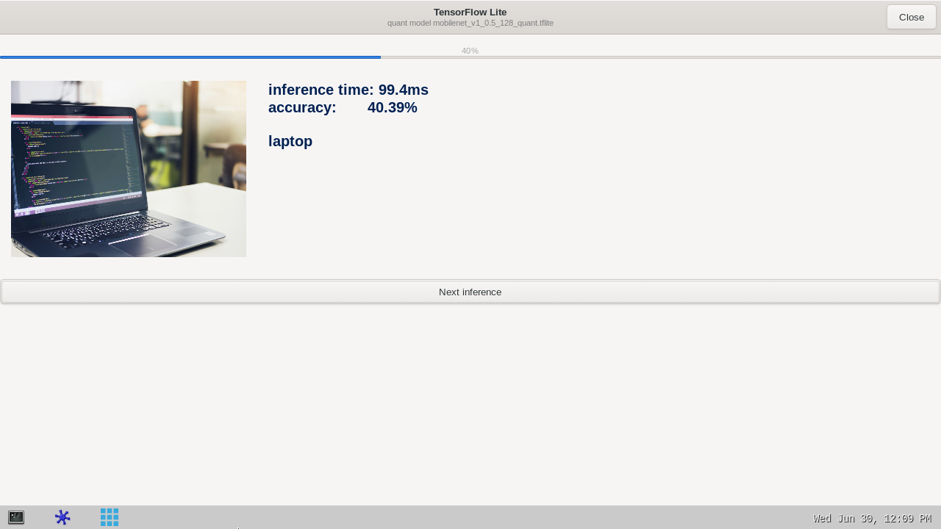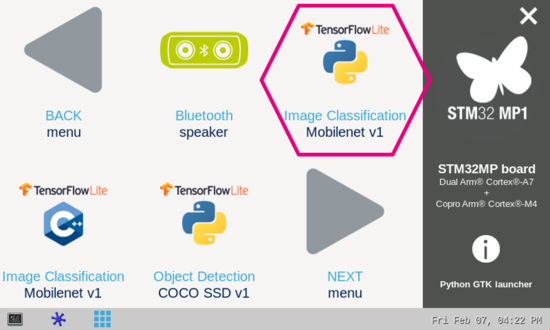This article explains how to experiment with TensorFlow Lite[1] applications for image classification based on the MobileNet v1 model using TensorFlow Lite Python runtime.
1. Description[edit source]
The image classification[2] neural network model allows identification of the subject represented by an image. It classifies an image into various classes.
The application enables OpenCV camera streaming (or test data picture) and the TensorFlow Lite[1] interpreter runing the NN inference based on the camera (or test data pictures) inputs.
It is a multi-process Python application that allows the camera preview (on CPU core 0) and the neural network inference (using CPU core 1) to run in parallel.
The user interface is implemented using Python GTK.
The model used with this application is the MobileNet v1 downloaded from the Tensorflow Lite hosted models[3].
2. Installation[edit source]
2.1. Install from the OpenSTLinux AI package repository[edit source]
After having configured the AI OpenSTLinux package you can install the X-LINUX-AI components for this application:
apt-get install tflite-cv-apps-image-classification-python
And restart the demo launcher:
systemctl restart weston@root
2.2. Source code location[edit source]
The label_tfl_multiprocessing.py Python script is available:
- in the Openembedded OpenSTLinux Distribution with X-LINUX-AI Expansion Package:
- <Distribution Package installation directory>/layers/meta-st/meta-st-stm32mpu-ai/recipes-samples/tflite-cv-apps/files/image-classification/python/label_tfl_multiprocessing.py
- on the target:
- /usr/local/demo-ai/computer-vision/tflite-image-classification/python/label_tfl_multiprocessing.py
- on GitHub:
3. How to use the application[edit source]
3.1. Launching via the demo launcher[edit source]
3.2. Executing with the command line[edit source]
The Python script label_tfl_multiprocessing.py application is located in the userfs partition:
/usr/local/demo-ai/computer-vision/tflite-image-classification/python/label_tfl_multiprocessing.py
It accepts the following input parameters:
usage: label_tfl_multiprocessing.py [-h] [-i IMAGE] [-v VIDEO_DEVICE] [--frame_width FRAME_WIDTH] [--frame_height FRAME_HEIGHT] [--framerate FRAMERATE]
[-m MODEL_FILE] [-l LABEL_FILE] [--input_mean INPUT_MEAN] [--input_std INPUT_STD]
optional arguments:
-h, --help show this help message and exit
-i IMAGE, --image IMAGE
image directory with image to be classified
-v VIDEO_DEVICE, --video_device VIDEO_DEVICE
video device (default /dev/video0)
--frame_width FRAME_WIDTH
width of the camera frame (default is 320)
--frame_height FRAME_HEIGHT
height of the camera frame (default is 240)
--framerate FRAMERATE
framerate of the camera (default is 15fps)
-m MODEL_FILE, --model_file MODEL_FILE
.tflite model to be executed
-l LABEL_FILE, --label_file LABEL_FILE
name of file containing labels
--input_mean INPUT_MEAN
input mean
--input_std INPUT_STD
input standard deviation
3.3. Testing with MobileNet V1[edit source]
The model used for test is the mobilenet_v1_0.5_128_quant.tflite downloaded from Tensorflow Lite hosted models[3]
To ease launching of the Python script, two shell scripts are available:
- launch image classification based on camera frame inputs
/usr/local/demo-ai/computer-vision/tflite-image-classification/python/launch_python_label_tfl_mobilenet.sh
- launch image classification based on the pictures located in /usr/local/demo-ai/computer-vision/models/mobilenet/testdata directory:
/usr/local/demo-ai/computer-vision/tflite-image-classification/python/launch_python_label_tfl_mobilenet_testdata.sh
4. References[edit source]

